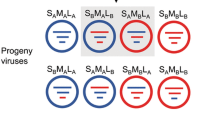Summary.
Infection and spread of group A rotaviruses under natural conditions are mostly limited to one animal host species. However, rare molecular evidence exists for interspecies transmission by whole virions of animal rotaviruses to humans. Human rotavirus strain HCR3, which was isolated in 1984 from a healthy infant in Philadelphia, U.S.A. was shown by RNA-RNA hybridization to form 11 hybrid bands with feline rotavirus strain FRV64 and canine rotavirus strains CU-1 and K9, but not with rotaviruses commonly found in humans. Thus, HCR3 was concluded to be originally a rotavirus circulating in cats and dogs and accidental interspecies transmission by whole virions to humans was likely to have occurred in the past.
Similar content being viewed by others
Author information
Authors and Affiliations
Additional information
Received May 12, 2000/Accepted June 5, 2000
Rights and permissions
About this article
Cite this article
Nakagomi, T., Nakagomi, O. Human rotavirus HCR3 possesses a genomic RNA constellation indistinguishable from that of feline and canine rotaviruses. Arch. Virol. 145, 2403–2409 (2000). https://doi.org/10.1007/s007050070029
Published:
Issue Date:
DOI: https://doi.org/10.1007/s007050070029




